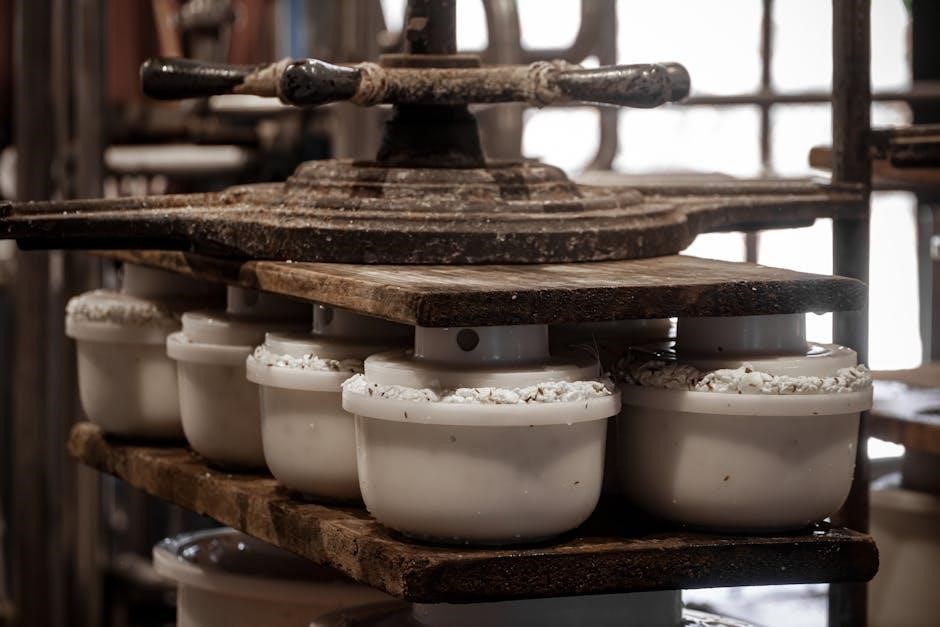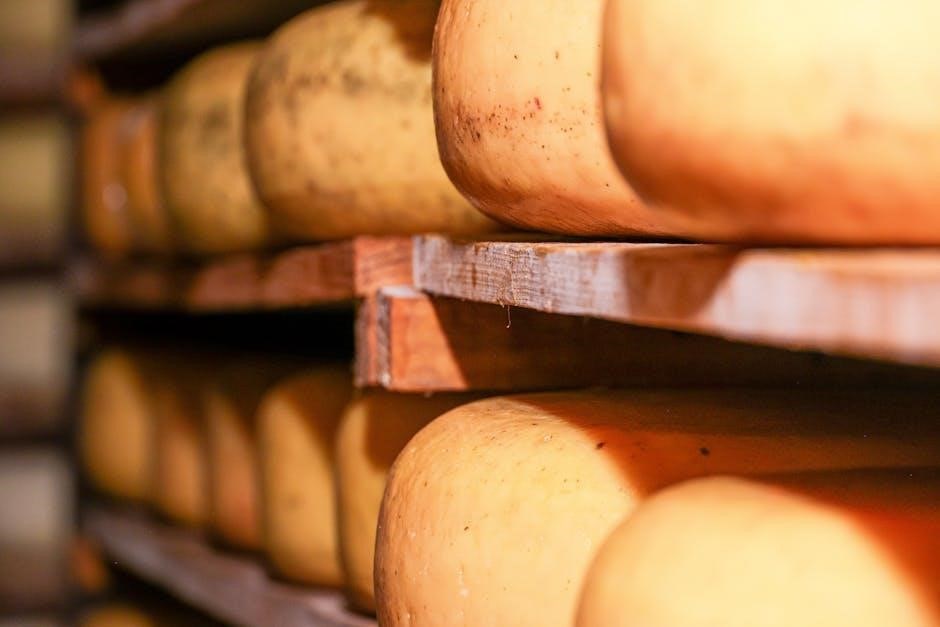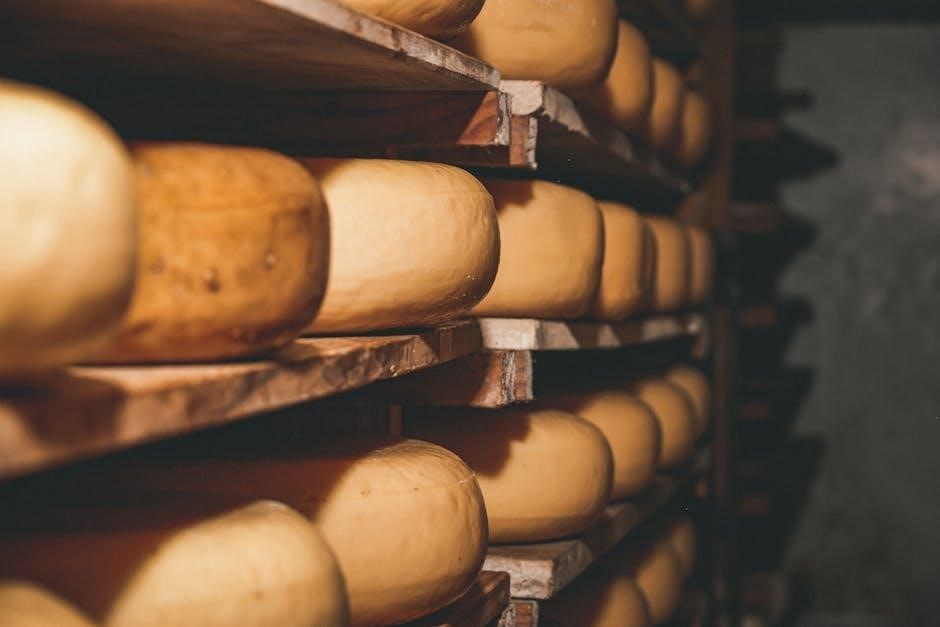The Noma Guide to Fermentation is a foundational cookbook by René Redzepi and David Zilber, exploring the science and creativity behind fermentation, with step-by-step techniques for home and professional use.
Overview of the Book
The Noma Guide to Fermentation is a comprehensive cookbook that delves into the science, techniques, and creativity behind fermentation. It explores a wide range of ferments, including lacto-fermentation, koji, miso, shoyu, and vinegar, offering detailed recipes and insights. Aimed at both home cooks and professionals, the book provides accessible, step-by-step methods and inspiration for experimenting with fermentation. It highlights Noma’s innovative approach to this ancient practice, making it an indispensable resource for anyone passionate about elevating their cooking through fermentation.
Authors: René Redzepi and David Zilber
René Redzepi, chef and co-owner of the renowned restaurant Noma, and David Zilber, former director of Noma’s fermentation lab, collaborated on The Noma Guide to Fermentation. Redzepi is celebrated for his innovative use of local ingredients, while Zilber’s expertise in fermentation revolutionized Noma’s culinary approach. Together, they share their knowledge of fermentation techniques, offering a deep understanding of this transformative process. Their collaboration brings fermentation to life, making it accessible for both home cooks and professionals.
Noma’s Role in Fermentation
Noma, a four-time World’s Best Restaurant, has revolutionized culinary practices through its innovative use of fermentation. The restaurant’s fermentation lab, led by David Zilber, has become a cornerstone of its creativity, transforming local and seasonal ingredients into unique flavors. Noma’s approach has elevated fermentation from a traditional technique to a modern culinary art, influencing both home cooks and professional kitchens. Its work has redefined how fermentation can enhance and expand the possibilities of modern cuisine, making it indispensable in the kitchen.
The Importance of Fermentation at Noma
Fermentation is the cornerstone of Noma’s culinary philosophy, enhancing flavor profiles and preserving ingredients. It drives creativity and innovation, making it integral to every dish served at the restaurant.
Fermentation as a Foundation of Flavor
Fermentation is fundamental to Noma’s culinary approach, adding depth and complexity to dishes. Techniques like koji and lacto-fermentation create umami-rich flavors, while vinegars add brightness. These methods transform ingredients, enhancing their natural qualities and elevating them into extraordinary culinary experiences. Fermentation’s versatility allows it to balance and layer flavors, making it an indispensable tool in Noma’s kitchen. This approach ensures that every dish, from savory miso to tangy pickles, showcases fermentation’s transformative power.
Every Dish Includes Fermentation
Fermentation is an integral part of every dish at Noma, reflecting its commitment to enhancing flavor and creativity. From the brightness of vinegar to the depth of miso, fermentation adds layers to each recipe. Whether it’s a tangy lacto-ferment or a savory koji-based sauce, every element is thoughtfully crafted to showcase fermentation’s versatility. This approach has earned Noma its reputation as a pioneer in modern cuisine, where fermentation is not just an ingredient but a cornerstone of innovation and taste.

Types of Fermentation Covered in the Guide
The guide explores lacto-fermentation, koji applications, vinegar production, and garum, offering a comprehensive look at the diverse techniques and ingredients used in fermentation.
Lacto-Fermentation
Lacto-fermentation is a foundational process in Noma’s culinary approach, utilizing lactic acid bacteria to preserve and enhance flavors. This method is central to creating sauerkraut, brined vegetables, and kimchi. The guide provides detailed instructions, emphasizing the importance of salt ratios and fermentation environments. For example, the book recommends using 2% of the cabbage’s weight in salt and pressing it with a water-filled bag to ensure proper anaerobic conditions. These techniques, refined at Noma, offer a comprehensive guide for both home cooks and professionals to master lacto-fermentation.
Koji and Its Applications
Koji, a fungus central to East Asian fermentation, is explored in depth by Noma. It breaks down proteins and fats, enhancing umami flavors. The guide details its role in creating miso and shoyu, and innovative applications beyond traditional uses, showcasing Noma’s creative fermentation techniques.
Vinegar and Garum
Vinegar and garum are essential components in Noma’s fermentation arsenal. Vinegar adds bright, tangy flavors, while garum, a fermented fish sauce, provides deep umami. The guide details natural vinegar production, emphasizing patience and precision, and explores garum’s versatility in enhancing dishes. These elements are fundamental to Noma’s pantry, offering transformative flavor profiles for both simple and advanced recipes.
Lacto-Fermentation Techniques
Lacto-fermentation involves salting and pressing vegetables to create lactic acid, preserving them. Noma’s guide shares methods like weighting cabbage and using tools to ensure proper fermentation.
Sauerkraut and Brined Vegetables
The Noma Guide to Fermentation details classic techniques for sauerkraut and brined vegetables, emphasizing salt ratios and pressing methods. A water-filled bag is often used to weigh down cabbage, ensuring even fermentation. These processes preserve vegetables while enhancing flavor and texture. The guide provides clear instructions, making these traditional methods accessible for home cooks and professionals alike. The result is tangy, nutritious ferments that add depth to various dishes, showcasing Noma’s dedication to simplicity and quality in fermentation.
Kimchi and Other Global Inspirations
The Noma Guide to Fermentation delves into the art of kimchi, offering innovative twists on this Korean classic. Beyond kimchi, the book explores global fermentation traditions, such as kefir, miso, and preserved lemons. These techniques highlight the diversity of fermented flavors, from spicy kick to umami richness. By adapting these methods, home cooks and chefs can infuse their dishes with vibrant, globally inspired ferments, creating a bridge between tradition and modern cuisine while maintaining Noma’s signature creativity and depth.
Equipment for Lacto-Fermentation
The Noma Guide to Fermentation emphasizes simple, accessible tools for lacto-fermentation. Essential equipment includes jars, crocks, or containers with lids to create an anaerobic environment. Weights, such as ceramic stones or a water-filled plastic bag, ensure vegetables stay submerged, preventing mold. Cheesecloth or a clean towel can cover jars during fermentation. These basic tools, often found in home kitchens, make lacto-fermentation approachable for both beginners and professionals, allowing anyone to craft vibrant, flavorful ferments with minimal investment.

Koji, Miso, and Shoyu
Koji, a key fungal catalyst, is central to creating miso and shoyu. The guide offers detailed techniques for fermenting these essential Japanese ingredients.
Understanding Koji
Koji, a fungus-based ingredient, is central to fermentation processes in Japanese cuisine. It breaks down proteins and carbohydrates, creating rich, umami flavors. The guide explains how koji transforms ingredients into miso, shoyu, and other ferments, highlighting its versatility. With detailed techniques, it simplifies the process of cultivating and applying koji, making it accessible for both home cooks and professionals. This section delves into the science and culinary applications of koji, offering a comprehensive understanding of its role in modern fermentation.
Making Miso
Making miso involves fermenting soybeans with koji and salt, creating a rich, savory paste. The guide details this traditional Japanese process, from preparing ingredients to aging the miso. It emphasizes the importance of time and patience, as the fermentation develops deep umami flavors. With step-by-step instructions, the book makes miso accessible to home cooks and professionals alike, offering both simple and complex recipes to explore its versatility in modern cuisine.
Shoyu (Soy Sauce)
Shoyu, or soy sauce, is a cornerstone of fermentation, explored in depth by Redzepi and Zilber. The guide reveals the intricate process of creating shoyu, blending soybeans, wheat, and koji before fermenting and aging. Detailed steps outline how to achieve the perfect balance of salty, umami flavors. The book demystifies shoyu production, offering practical methods for both home cooks and professionals to craft this essential condiment, enhancing dishes with its rich, savory profile.

Vinegar and Garum
Vinegar adds bright, tangy notes, while garum provides deep umami. The guide explores natural vinegar production and traditional garum, enhancing dishes with their bold, nuanced flavors.
Natural Vinegar Production
Natural vinegar production is a cornerstone of Noma’s fermentation techniques. The guide details how to craft vinegar through wild fermentation, emphasizing patience and precise conditions. It explores the transformation of wines, beers, and other liquids into tangy, flavorful vinegars. These natural vinegars add brightness and depth to dishes, serving as a versatile tool in both home and professional kitchens. The methods are approachable, with clear instructions for achieving consistent results, making vinegar a key component in enhancing culinary creations.
Garum: Fermented Fish Sauce
Garum, a traditional fermented fish sauce, is explored in depth as a savory, umami-rich condiment. The Noma Guide details its ancient origins and modern applications, offering recipes that balance tradition with innovation. By fermenting small fish like anchovies, the process creates a deep, briny flavor perfect for enhancing dishes. The guide provides clear, accessible methods for crafting garum at home or in professional kitchens, making it a versatile tool for elevating culinary creations with its bold, nuanced taste.

Equipment and Ingredients for Fermentation
The Noma Guide to Fermentation emphasizes essential tools like precise temperature control and salt balances, alongside the careful selection of quality ingredients for successful fermentation processes.
Essential Tools for Fermentation
The Noma Guide to Fermentation highlights the importance of having the right tools, such as glass jars, weights, and pH meters, to ensure precise control over the fermentation process. While advanced equipment can enhance results, the authors emphasize that simple, inexpensive tools are often sufficient for achieving high-quality ferments. The guide also stresses the value of creativity in repurposing household items, making fermentation accessible to both home cooks and professional chefs. This approach underscores Noma’s commitment to innovation and practicality in fermentation practices;
Choosing the Right Ingredients
The Noma Guide to Fermentation emphasizes the importance of selecting high-quality, seasonal, and locally sourced ingredients to achieve optimal results. The authors stress that the freshness, variety, and organic quality of ingredients directly impact the fermentation process. From vegetables to grains and legumes, careful selection ensures vibrant flavors and successful ferments. The guide also highlights the value of understanding the origin and potential of each ingredient, aligning with Noma’s commitment to elevating simple materials into extraordinary culinary experiences through fermentation;

Recipes and Step-by-Step Guides
The Noma Guide to Fermentation offers comprehensive recipes and detailed instructions, blending simplicity with advanced techniques to create a wide range of fermented dishes for all skill levels.
Simple Fermentation Recipes
The Noma Guide to Fermentation provides accessible recipes for beginners, including sauerkraut, brined vegetables, and kimchi, with clear, step-by-step instructions. These dishes are designed to be approachable while introducing fundamental fermentation principles. The guide emphasizes using basic kitchen tools and ingredients, making fermentation achievable for home cooks. These simple recipes serve as a gateway to understanding the transformative power of fermentation, offering a balance of simplicity and depth that appeals to both novices and experienced chefs.
Detailed Instructions for Advanced Ferments
The guide offers in-depth recipes for complex ferments like koji, miso, and garum, providing detailed step-by-step methods. Advanced techniques are explained with scientific precision, ensuring success for experienced practitioners. From creating fermented fish sauce to crafting intricate miso blends, the book delivers meticulous guidance, balancing tradition with innovation. These detailed instructions cater to professionals and fermentation enthusiasts, offering a comprehensive resource for mastering advanced methods and exploring the full potential of fermentation.

Beyond the Basics: Less Common Ferments
Beyond traditional ferments, the guide explores less common techniques, such as blackened beets and wild mushroom ferments, offering unique flavors and textures for adventurous cooks.
Black Fruits and Vegetables
The guide delves into the fascinating world of blackened fruits and vegetables, showcasing techniques to unlock their deep, umami-rich flavors. Black beets, for instance, are transformed through precise fermentation, creating a sweet and earthy profile. Similarly, black currants and other dark-hued produce are highlighted for their unique potential in ferments. These methods push the boundaries of traditional fermentation, offering chefs and home cooks innovative ways to incorporate these striking ingredients into modern dishes, adding complexity and visual appeal to any plate.
Fermented Grains and Legumes
Fermented grains and legumes are explored in depth, offering a rich source of umami and nutrients. The guide highlights techniques for fermenting barley, oats, and legumes like lentils and chickpeas, emphasizing their versatility in both traditional and modern dishes. Koji, a key fermentative agent, is used to break down grains into sweet, savory compounds. These methods not only enhance flavor but also improve digestibility, making them a valuable addition to any culinary repertoire, whether for home cooking or professional kitchens.

The Science Behind Fermentation
Fermentation relies on microbial activity, converting sugars into acids or alcohol. pH levels drop, preserving ingredients and enhancing flavors through enzymatic breakdown, governed by precise conditions and timing.
Microbiology of Fermentation
Fermentation is driven by microorganisms like bacteria, yeast, and mold, which feed on sugars to produce acids, alcohol, or carbon dioxide. Lactic acid bacteria, such as Leuconostoc and Lactobacillus, are central to lacto-fermentation, creating the tangy flavors in sauerkraut and kimchi. Understanding microbial behavior, including their tolerance for salt, temperature, and oxygen, is key to controlling fermentation processes. This microbial activity not only preserves food but also enhances its nutritional value and complexity, making it a cornerstone of Noma’s culinary innovation.
Understanding pH Levels
Monitoring pH levels is crucial in fermentation, as they determine the environment for microbial growth. Fermentation typically thrives in acidic conditions, with most processes occurring between pH 4.0 and 6.0. Lactic acid bacteria, for instance, favor slightly acidic to neutral pH, while yeasts tolerate broader ranges. Tracking pH ensures the dominance of desirable microorganisms and prevents harmful pathogens. This balance is essential for both the safety and quality of ferments, guiding the creation of Noma’s signature flavors and textures through precise control.
Noma’s Approach to Innovation
Noma’s approach to innovation lies in its commitment to culinary experimentation, blending traditional techniques with creative fermentation methods to redefine modern cuisine and push flavor boundaries.
Experimental Fermentation Techniques
Noma’s fermentation lab, led by David Zilber, pioneered groundbreaking methods like lacto-fermentation, koji applications, and garum production. These techniques transformed traditional processes, creating unique flavors and textures. The guide shares these innovative approaches, from black fruit fermentation to experimental legume treatments, offering a fresh perspective on culinary creativity.
By pushing boundaries, Noma’s team redefined fermentation, inspiring home cooks and professionals to explore new possibilities in modern cuisine.
Integrating Ferments into Modern Cuisine
Noma’s approach emphasizes blending fermentation into modern dishes seamlessly, enhancing flavors without overpowering them. Techniques like adding a splash of garum or a drizzle of vinegar create depth and complexity. The guide demonstrates how ferments can elevate sauces, marinades, and seasonings, making them integral to contemporary cooking. By incorporating these elements, Noma showcases fermentation as a versatile tool for innovation, balancing tradition with cutting-edge creativity.
This method inspires chefs to view ferments as essential components of modern cuisine, rather than standalone elements.

Customer Reviews and Feedback
Readers praise the guide for its detailed recipes and scientific insights, making fermentation accessible to home cooks and professionals alike. Many find it inspiring and practical.
What Readers Say About the Guide
Readers enthusiastically praise The Noma Guide to Fermentation for its comprehensive approach, calling it a game-changer for both home cooks and professionals. Many highlight the detailed step-by-step instructions, making complex ferments accessible. The inclusion of history, science, and practical tips adds depth, while the variety of recipes, from lacto-ferments to koji, inspires creativity. Fans appreciate the balance between sophistication and usability, making it a must-have for fermentation enthusiasts. The guide has sparked widespread enthusiasm, with many calling it an essential kitchen resource.
Practicality and Usability
The Noma Guide to Fermentation is celebrated for its practicality and usability. It offers detailed, easy-to-follow instructions, making fermentation accessible to both home cooks and professionals. The inclusion of both written and pictorial guides ensures clarity, allowing readers to grasp complex techniques effortlessly. This balance of sophistication and accessibility has made the guide indispensable for fermentation enthusiasts, proving that advanced methods can be both approachable and rewarding.

The Impact of The Noma Guide to Fermentation
The Noma Guide to Fermentation has revolutionized home cooking and professional kitchens, inspiring a new generation of fermenters and redefining culinary creativity globally.
Changing Home Cooking and Professional Kitchens
The Noma Guide to Fermentation has transformed cooking practices worldwide. Home cooks now embrace fermentation with confidence, while professional kitchens integrate its techniques into modern cuisine. The book’s detailed instructions and creative approaches have made fermentation accessible to all, fostering innovation and experimentation. It bridges the gap between traditional methods and contemporary flavors, inspiring a culinary movement that redefines how we cook and think about food. Its influence is evident in kitchens of all levels, from amateur to Michelin-starred.
Inspiring a New Generation of Fermenters
The Noma Guide to Fermentation has ignited a passion for fermentation among both enthusiasts and professionals. By demystifying complex techniques, it has empowered a new generation to experiment and innovate. The book’s clear instructions and creative approaches have made fermentation accessible, sparking a global interest in preserving and enhancing flavors. It has fostered a sense of community and inspired countless home cooks and chefs to explore the endless possibilities of fermentation, blending tradition with modern culinary artistry.
The Noma Guide to Fermentation is a transformative resource, offering deep insights into fermentation’s culinary potential. It inspires innovation and elevates both home and professional cooking.
Final Thoughts on the Guide
The Noma Guide to Fermentation is a groundbreaking resource that redefines fermentation’s culinary potential. It offers accessible, detailed techniques for both home cooks and professionals, ensuring fermentation’s creativity and science are within reach. With Noma’s closure in 2024, this guide stands as a timeless legacy, inspiring future generations to experiment and innovate in the kitchen. Its comprehensive approach and inspiring recipes make it an indispensable tool for anyone passionate about elevating their cooking through fermentation.
Fermentation’s Future in Cooking
Fermentation’s future in cooking is poised for innovation and accessibility. The Noma Guide to Fermentation has democratized complex techniques, inspiring home cooks and professionals alike to explore new flavors and textures. As fermentation gains global traction, it promises to redefine culinary creativity, blending tradition with experimentation. With its emphasis on science and creativity, this guide ensures fermentation will remain a cornerstone of modern cuisine, driving the discovery of bold, unexpected flavors and reimagining the way we approach food.





